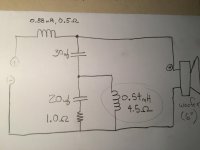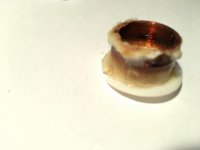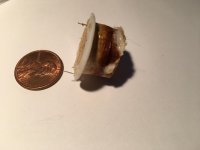Hello Everyone,
I just have a simple question.
Recently I aquired a pair of Infinity Reference 2000.3 speakers. Not being the kind who lets things be, I opened up the speaker to take a gander at the innards, with the idea of replacing some electrolytics. What I found was typical enough, except there is an inductor labeled 550uH constructed with very fine wire, maybe 30-32 gauge. Heres the rub, the inductor apparently heated up burning the enamel and melting the plastic former. I measured the inductor and it still reads 540uH with a resistance of 4.6 ohms. So to be safe I went to replace it and the new inductor is made with 22 gauge wire and as you’d expect has a resistance of 0.6 ohms.
So, is the fix simple as just adding four ohms in series with the new inductor?
Was the oem inductor made with such fine wire to act as a fuse?
or was the inductors 4.6 ohms factored in as a form of eq?
Attached is a schematic of the cross over and a picture of the burnt inductor.
Thanks for the help.
Bob
I just have a simple question.
Recently I aquired a pair of Infinity Reference 2000.3 speakers. Not being the kind who lets things be, I opened up the speaker to take a gander at the innards, with the idea of replacing some electrolytics. What I found was typical enough, except there is an inductor labeled 550uH constructed with very fine wire, maybe 30-32 gauge. Heres the rub, the inductor apparently heated up burning the enamel and melting the plastic former. I measured the inductor and it still reads 540uH with a resistance of 4.6 ohms. So to be safe I went to replace it and the new inductor is made with 22 gauge wire and as you’d expect has a resistance of 0.6 ohms.
So, is the fix simple as just adding four ohms in series with the new inductor?
Was the oem inductor made with such fine wire to act as a fuse?
or was the inductors 4.6 ohms factored in as a form of eq?
Attached is a schematic of the cross over and a picture of the burnt inductor.
Thanks for the help.
Bob
Attachments
Last edited:
Who knows why they did it that way? I doubt it was meant as a pseudo fuse, that's not a good way to do it. EQ would have been factored in whether intended or not. Judging by the result I'd guess it was simply not a good choice, assuming they weren't abused. Yes, add the resistor.
Infinity was not known for consistently well thought out crossover designs. They reached some of them very empirically.
It may not be a bad idea to rethink the crossover after measuring.
Best,
Erik
It may not be a bad idea to rethink the crossover after measuring.
Best,
Erik
- Status
- Not open for further replies.


